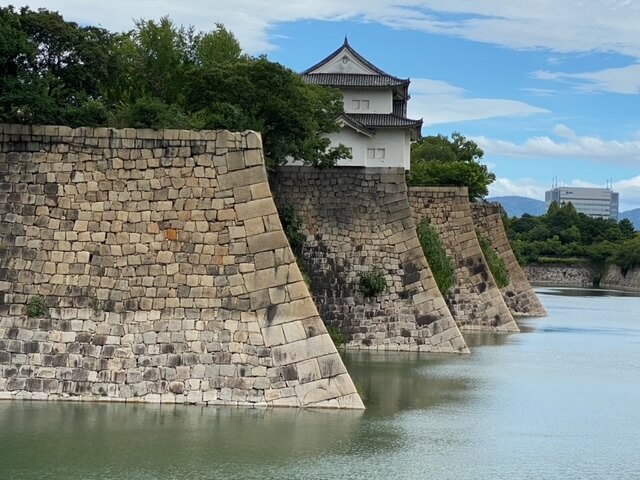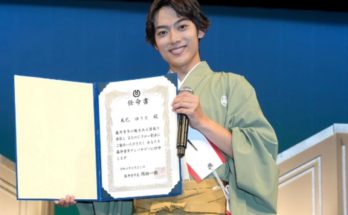Osaka Castle is the most popular historical sightseeing spot in Osaka. Have you ever been to Osaka and visited Osaka Castle? Many foreign visitors used to visit Osaka Castle before the corona pandemic. I will introduce some parts among many Osaka Castle’s seeing spots in several installments. I hope you have a feeling you’re joining the tour of Osaka Castle. Today is part 1. Let’s get started.
Location and 3 Famous Feudal Lords
First of all, I would like to explain the location of Osaka Castle and three famous feudal lords related to Osaka Castle. I will show you maps and portraits.
Now, the ground has been reclaimed. However, when the Osaka Castle was built about 420 years ago (around 1600), this area was surrounded by many rivers and the nearby Osaka Bay. It was easy to move or transport to other cities, such as Kyoto or Nara, through waterways.


Also, it was accessible to visit here for many people, like messengers, scholars, investigators, merchants, architects, monks, or missionaries from foreign countries after arriving through Osaka port. They introduced their culture or products here. And this place is a tableland plateau, so people could look out over the entire Osaka city from here. It was advantageous in war too. Historically, Osaka was the political, cultural, and economic center of Japan. That’s why many people wanted this place as their headquarters, such as powerful feudal lords, the Shogun, and the Emperor.
Before the castle was built, there was a temple called Ishiyama Honganji temple (1533-1580). One famous feudal lord, Nobunaga Oda, attacked the temple to try to take this area. However, the battle ended in a draw. Nobunaga was unable to build his castle here. Probably, he was disappointed and upset.
I gave a nickname to Nobunaga and the two other famous feudal lords related to Osaka Castle in order to make it easier for you to know and remember their characters.

Nobunaga is Mr. Short-tempered. He was active and aggressive, as well as quite a strict person who angered quickly. In practice, Nobunaga’s forceful personality led to his assassination by one of his retainers, Mitsuhide Akechi (1582).

After Nobunaga was assassinated, his other retainer, Hideyoshi Toyotomi, constructed Osaka Castle here.
Hideyoshi is Mr. Performer. Despite being born into a poor family, Hideyoshi got in good with his bosses, such as Nobunaga Oda. They acknowledged his impressive performance in war, politics, and communication by giving him a promotion. He was good at grabbing people’s hearts. Many powerful feudal lords, including Nobunaga, took him under their wings. He became a top Samurai and constructed his castle here (1583-1598). It might be better to call him Mr. Success.

Hideyoshi’s rival, Ieyasu Tokugawa, is Mr. Patience. He could wait a long time in order to seize the opportune moment. He created a peaceful period called the Edo era (1603-1868). He became the first Shogun in the Edo era. He also defeated the Toyotomi family and had his son construct the second Osaka Castle here.

After Hideyoshi Toyotomi passed away (1598),his son, called Hideyori Toyotomi , and Ieyasu Tokugawa began the war. Tokugawa’s side beat Toyotomi’s side. Ultimately, the Toyotomi family was defeated. Hideyori Toyotomi burned down the first Osaka Castle (1615), his own home, shortly before committing suicide. After that, Ieyasu’s son, known as Hidetada Tokugawa, built the second Osaka castle in the same place (1620∼), to replace the one that was lost. In other words, the current Osaka castle you see today was created by the Tokugawa family.
That’s a rough explanation of the location and history of Osaka Castle.

Moat
Here is the corner of this castle’s south and west sides, with about 100 hectares (about 250 acres). When the original castle was built, the total area was three or four times larger than it is now. After the first Osaka Castle was burned down, the Tokugawa Shogunate completely reclaimed the ground and constructed the second Osaka Castle here. They also re-dug the moats. The outer and inner moat surround the main tower by about 20 km in total length. This moat is about 75m wide and about 10m deep. There were many watchtowers along the moats, but some of them were destroyed during the war and the Meiji Restoration (1868-1889). The No6 watchtower has remained until now. Osaka Castle’s soldiers shot a gun at enemies from the watchtowers, but the enemies’ bullets didn’t reach the watchtower due to the moat’s width of 75 m and the height difference. The height of the stone wall is about 30 meters, like a 7- or 8-story building. The watchtowers were built on the stone wall. The inner side is higher than the outer side so that enemies could not go against those watchtowers. The width of the moat was decided based on the firing range of the gun at that time. Of course, the moat had an essential role in protecting from enemy attacks.

Next, let’s talk about the water of the moat. The water used to be spring water, but the water level was sometimes lowered due to many wars, and the construction of a subway in the 1960s cut off the water vein. The water quality differs depending on the area. The south and west moat’s water is treated water, but the east and north moat are filled with natural water. And the east moat has a different system to eliminate pollution and purify water. The water of the east section is cleaner than in other parts. In practice, the swim games of the International Triathlon in 2017 were held in the eastern moat.

Stone Walls
Japanese castle walls have a unique shape. In Western countries, castle walls were made of blocks and stacked horizontally. However, Japanese castle walls are made of stone and shaped like this. The stone walls of Osaka Castle are especially elaborate. It was necessary to stack stones alternately to withstand earthquakes. In Japan, small earthquakes occur frequently. That shape is like a toy called Jenga. The reason that Jenga can be stacked so high is because they are stacked alternately. Of course, it had a role in preventing the enemy from entering. Even if enemies invaded the moat, they could not easily climb that shaped stone wall. If you ever want to build a stone wall like that today, this is a very interesting story for you. You would need to calculate the measurements with complicated formulas. I wonder how the people of that time made these shaped stone walls without using calculators.


The lower equation is the formula for incline
Each alphabet represents length, angles, etc. You need these formulas to build a stone wall that is shaped like the ones around Osaka Castle
I would like to end today with this. In the following article, I will introduce the main entrance of Osaka Castle, Otemon Gate. Thank you for reading. See you next time.
I live in Osaka. I’m a volunteer guide trainee. I want to take you to many good sightseeing spots when you visit Osaka!





 HTJ has a YouTube page! Check it out
HTJ has a YouTube page! Check it out
Hi, Toshie san!
I’m Akiko from Hapa Buddies.
I enjoyed your article, and shared your 2 articles about Osaka castle with my friend.
She lives in Kyobashi, but said that she learned about Osaka castle lot from your articles, and would share them with international students.
Thank you, Akiko san. I am sorry for not getting back to you soon. I am so happy that you shared my article. Thank you for reading and comment as well.